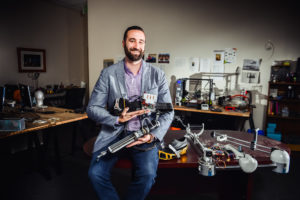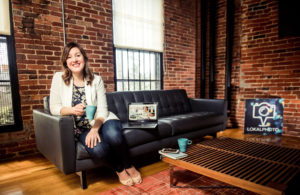One of the most powerful interactions Brad Hennessie has ever had with a patient was with a woman who had been going to physical therapy for years after suffering a stroke.
The patient had been unable to go to the beach because of the stroke’s aftermath, but she longed to feel the sand between her toes. As a lead clinical research specialist for the University of Maryland School of Medicine at that time, Hennessie had helped to develop an assistive therapeutic robot for stroke victims who suffer from a condition known as foot drop. Foot drop occurs when the front portion of a foot is difficult to lift, causing patients to need crutches or braces for walking.

Instead of crutches, the patient used Hennessie’s robot for six weeks and attended his exercise group. She then was able to go to Ocean City and feel the cool water as it swept over her feet. She hasn’t worn a brace since.
“That was one of my biggest drivers (for) quitting my job (at UM) to do this full time,” Hennessie says. And now, he and fellow researcher Rich Macko have founded NextStep Robotics, which is commercializing the robot to help others. Still in development, the Baltimore-based company hopes to have a product ready by fall.
NextStep is one of a rising number of technology-based companies that call
Baltimore home, a number that is not surprising considering the scrappy do-
it-yourself spirit of Charm City.
The solution seekers
“We created a solution initially,” Hennessie says. “We didn’t set out to create a product and to create a company. That was almost accidental. We created a solution to a problem that patients were telling us they needed.”
The initial exercise-research group aimed to prove that it is safe for stroke survivors to exercise at the same level of intensity as people who have not had a stroke. Researchers discovered that while stroke patients could hit the same intensity level, they could not increase the speed of the treadmill or its grade because of foot drop. Researchers considered available devices and braces, but all of them kept the foot at a 90-degree angle, not allowing the patient to train an ankle to improve.
“We met with physical therapists to really decide what our training protocol would be, because we wanted this to be a therapeutic (and) not an assistive device,” Hennessie says. “We didn’t want patients to have to wear this forever. We really wanted them to actually get rid of the assistive devices they were using.”
After six weeks of using the robot, 85 percent of patients discarded their assistive devices; for some, it was years after suffering a stroke. “What we have seen by (the robot) targeting the ankle specifically with our rehab program is that we change the kinematics in the gait pattern in their knee and their hip as well,” he says. “Compensatory actions on their other foot decrease.”
Physical therapy commonly focuses on executing daily activities, such as feeding and clothing oneself or personal hygiene. “That is important, but it shouldn’t stop there,” Hennessie says. “It should really go toward activities of community living because when we give patients the ability to access their community again, they get their life back essentially.”
The door openers
In addition to the city’s medical universities, another place helping to advance the dreams of local entrepreneurs is Emerging Technology Centers, which offers two campuses with co-working spaces and an incubator program that provides mentors and guidance to fledgling businesses.
“I consider it my job to make an economic impact on the City of Baltimore one entrepreneur at a time because entrepreneurial jobs and start-ups are the lifeblood not just of this city, but of lots of other places,” says Deb Tillett,
executive director and president. “I’m going to give [entrepreneurs] what they need when they need it. If that means they need me to open a door, if that means they need to meet a venture capitalist or get ready for an investor pitch, then that is what I am going to do for them.”
In February, the Sweden-based research and advisory firm UBI Global ranked ETC seventh worldwide out of incubators that work with area higher-education facilities. Founded in the late 1990s, ETC has worked with more than 450 companies; 85 percent are still in business, and in the past decade, ETC-supported companies have brought in more than $2.4 billion in outside investment to this region. Last year alone, staff worked with 170 companies. A 2016 economic impact study showed that companies with which ETC has worked have created more than 6,000 jobs with a $1.2 billon economic impact on the state and an $800,000 economic impact on Baltimore City.
This growth has been and continues to be fascinating for Tillett. “It’s interesting. It felt slow moving, but it really wasn’t,” she says. “Think about the advances in just the last 10 years. It has been absolutely
incredible.”
The connectors
Marianne McGinley founded Lokalphoto, a centralized booking photography platform, in 2015 and joined ETC in December. “It’s been great for me to have a spot outside of my home so that I can focus on getting my work done,” she says. “The energy here is fantastic. I’m working alongside lots of other start-up founders who are solving similar types of challenges in different industries. For me, that has been most helpful — sharing and learning from them.”

McGinley dreamed up the business idea when she had a lot of difficulty finding a photographer who was both available and within her budget to take pictures of her small children. “I talked with some of my friends who are also busy moms and I realized I wasn’t the only one behind the eight ball,” she says. “We were all struggling to find photographers when we needed them, and I realized a centralized photography marketplace would be very useful for all of us.”
The platform gives transparency of pricing and availability, thus eliminating the time consumption of back-and-forth correspondences. There is also a messaging feature on the site so customers can communicate in advance of booking. Photographers, amateur and professional, receive a dedicated place to showcase their work while customers can find a photographer in a city where they live or plan to visit. The site has no joining fee and a growing number of photographers, 200 so far, some as far away as Hawaii.
“I don’t think photography has ever been as accessible as it is through LokalPhoto,” McGinley says. “Even if it is the simplest of occasions — a birthday party or an anniversary and you would like to have some amazing photos — it has never been easier to find and book a photographer than it is through Lokalphoto.”
McGinley believes Baltimore is a great place for technology companies because it has a small-city feel with great collaborative connectivity. “There is an underdog mentality to our city,” she says. “We’ve got this immense pride for our beautiful, accessible, quirky place that we call home, and we want to see our city thrive. So our pride carries through into how we engage and support other businesses that are based here in Baltimore.”




